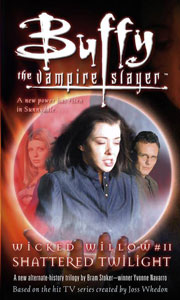“Wicked Willow II: Shattered Twilight” (July 2004), the middle chapter of Yvonne Navarro’s trilogy, doesn’t have a lot of plot to it, but – part purposefully, part accidentally, perhaps – it’s a good meditation on how we define good and evil and why factions fight each other. As with the first entry, “The Darkening,” Willow is gathering magical power and – along with her coven of 12 witches – researching ways to resurrect Tara; this mostly happens off-page. But I liked this book more, perhaps because I’ve grown accustomed to the concept of this Season 6 alternate trilogy that essentially asks “What if Willow was evil for a longer time period?”
While it can be contended that Willow doth protest too much in whipping her coven members into shape and complaining that Buffy and her gang are a bunch of annoying do-gooders, “Shattered Twilight” does raise the interesting question of who gets to decide which heroes have moral authority. After all, Buffy’s actions – or lack thereof – got Tara killed. It wasn’t intentional, certainly, but is intent all that matters?
Underlining that point further, Buffy instructs the Frankenstein’s-monster-esque Riley-golem to smash everything in Willow’s headquarters, and it leads to the deaths of some witches. Buffy didn’t intend that, but couldn’t she have worded the instructions better?
Meanwhile, as the gang finally learns toward the end, Willow just wants to resurrect Tara. Everything she has done is in service to that, and the gang hadn’t stopped think about Willow’s goal, they just reacted to her gathering of power. Even as it treads water in the overall plot, “Shattered Twilight” is a nice meditation on both the cycle of reactionary violence and the fear of future violence from a declared enemy.
Navarro also serves up some meaty character stuff. She’s always been the best writer of Anya among the spinoff fiction authors – see “Tempted Champions,” which she also references here via Buffy’s reflections on the Slayer-vampire Celina. But it’s not necessarily because she knows Anya better than other writers, it’s because she’s willing to go beyond using Anya as a quip machine. Here, Anya devises and performs a spell to allow Giles to walk again, and Navarro nicely shows Giles’ thrill at regaining his old lifestyle.
Meanwhile, as mentioned, Willow puts Riley’s spirit into a golem to defend her loft-apartment HQ. Riley had died in warfare in this alternate timeline. This allows for some nice writing from Buffy’s perspective about the loss of Riley and how she had bungled their relationship.
I thought it was curious that Willow hadn’t recruited Amy Madison in “The Darkening,” but she enters the picture here as the one witch who joins up willingly. Navarro doesn’t do a lot with Amy yet, though. It’s also somewhat surprising that Jonathan and Andrew are out there somewhere, hiding from Willow, yet they aren’t part of this narrative at all; Willow seems to have gradually stopped thirsting for revenge against Warren’s accomplices.

Also in the underused character category are Spike and Oz, who remain chained up in Willow’s HQ. Although the Ghost of Tara tells the Scoobies that Willow keeps them there for “companionship,” holding Spike and Oz as prisoners seems like the least necessary cruel thing Willow is doing right now. It doesn’t even make a lot of strategic sense, although I suppose they could be bargaining chips down the road.
While “Shattered Twilight” digs into the wrong assumptions that can cause conflicts to grow into wars, at the end of the day – even after sifting through the nuances of heroes’ imperfections and villains’ humanity – it’s not wrong to label Willow as the bad guy of this piece. In this timeline, Xander’s gonna have a heckuva time talking her back from the brink.
Click here for an index of all of John’s “Buffy” and “Angel” reviews.

